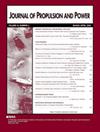喷油器在出口达到超临界流动的要求
IF 2.4
4区 工程技术
Q2 ENGINEERING, AEROSPACE
引用次数: 0
摘要
先进的发动机设计和替代燃料为航空燃气轮机和柴油发动机引入了超临界燃料喷射的可能性,就像许多火箭发动机一样。以往的研究主要集中在喷射后超临界状态下的燃料-空气混合。然而,喷射器在出口达到超临界流动的要求尚未得到系统的研究。本文采用计算流体动力学方法,结合真实气体模型和由亥姆霍兹状态方程导出的流体特性,对喷射器内的超临界流动进行了分析。根据燃料的不同,说明了三个操作挑战:1)喷油器内压力和温度的大幅下降,2)喷油器堵塞,以及3)超临界射流的超音速膨胀。通过开发和验证注入器中超临界流动的一维非等熵模型,可以解决这些挑战。这种降阶模型可以指导不同燃料和应用的喷油器设计,并有助于将喷油器超临界流与下游腔室的超临界流解耦,从而显着减少燃料-空气混合模拟的计算工作量。结果表明,要实现超临界喷射,通常需要更大直径的喷油器,且单位面积燃油能量喷射率与典型柴油喷油器相当。本文章由计算机程序翻译,如有差异,请以英文原文为准。
Fuel Injector Requirements to Achieve Supercritical Flow at the Exit
Advanced engine designs and alternative fuels introduce the possibility of supercritical fuel injection in aviation gas turbines and diesel engines, as is already the case for many rocket engines. Previous studies have focused mainly on fuel–air mixing in the supercritical regime after injection. However, injector requirements to achieve supercritical flow at the exit have not been investigated systematically. In this study, supercritical flow in an injector is analyzed using computational fluid dynamics with a real gas model and fluid properties derived from Helmholtz equations of state. Three operational challenges are illustrated depending upon the fuel: 1) large decreases in pressure and temperature within the injector, 2) injector choking, and 3) supersonic expansion of the supercritical jet. These challenges are addressed by developing and validating a one-dimensional, nonisentropic model of supercritical flow in the injector. This reduced-order model can guide injector designs for different fuels and applications and help decouple the injector supercritical flow from that in the downstream chamber to significantly reduce the computational effort for fuel–air mixing simulations. Results show that larger-diameter injectors are generally required to achieve supercritical injection with a fuel energy injection rate per unit area matching that of a typical diesel injector.
求助全文
通过发布文献求助,成功后即可免费获取论文全文。
去求助
来源期刊

Journal of Propulsion and Power
工程技术-工程:宇航
CiteScore
4.20
自引率
21.10%
发文量
97
审稿时长
6.5 months
期刊介绍:
This Journal is devoted to the advancement of the science and technology of aerospace propulsion and power through the dissemination of original archival papers contributing to advancements in airbreathing, electric, and advanced propulsion; solid and liquid rockets; fuels and propellants; power generation and conversion for aerospace vehicles; and the application of aerospace science and technology to terrestrial energy devices and systems. It is intended to provide readers of the Journal, with primary interests in propulsion and power, access to papers spanning the range from research through development to applications. Papers in these disciplines and the sciences of combustion, fluid mechanics, and solid mechanics as directly related to propulsion and power are solicited.
 求助内容:
求助内容: 应助结果提醒方式:
应助结果提醒方式:


